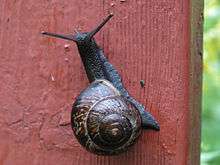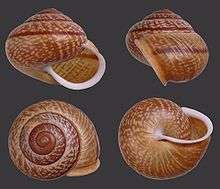Arianta arbustorum
Arianta arbustorum is a medium-sized species of land snail, sometimes known as the "copse snail", a terrestrial pulmonate gastropod mollusk in the family Helicidae.
| Arianta arbustorum | |
|---|---|
 | |
| Scientific classification | |
| Kingdom: | |
| Phylum: | |
| Class: | |
| (unranked): | clade Heterobranchia clade Euthyneura clade Panpulmonata clade Eupulmonata clade Stylommatophora informal group Sigmurethra |
| Superfamily: | |
| Family: | |
| Subfamily: | Ariantinae |
| Genus: | |
| Species: | A. arbustorum |
| Binomial name | |
| Arianta arbustorum | |
| Synonyms | |
Subspecies
Several subspecies are recognized by some authors:
- Arianta arbustorum alpicola Férussac, 1821
- Arianta arbustorum arbustorum
- Arianta arbustorum canigonensis
- Arianta arbustorum picea
- Arianta arbustorum pseudorudis
- Arianta arbustorum repellini
- Arianta arbustorum styriaca
- Arianta arbustorum vareliensis
Distribution
This species is native to Europe:
- North-western and central Europe with Alps and Carpathians[3]
- Netherlands[4]
- Austria
- Czech Republic
- Slovakia
- Poland
- Switzerland. One of the most frequent species of land snails in Switzerland, can be very abundant, up to 20 adults per square meter.[3]
- eastern Pyrenees, Spain[3]
- Norway[3]
- Iceland[3]
- Faroe Islands[5]
- the British Isles: Great Britain and Ireland[3] In Britain the species suffered slightly from intensive farming and the continuous destructions of suitable uncultivated refuges.[3] It is rare in Ireland.[3]
- Kaliningrad[3]
- Finland. In Finland, it has become so common in the Porvoo region east of Helsinki, that it is locally called the "Porvoo snail".
- Estonia[3]
- Latvia[3]
- scattered to Serbia[3]
- Bulgaria[3] It is rare in Bulgaria.[3]
- western Ukraine[3]
Arianta arbustorum is introduced to North America, but is only known from Canada, where established populations are known from Newfoundland, New Brunswick, Ontario,[6] and Prince Edward Island.[7]
This species has not yet become established in the US, but it is considered to represent a potentially serious threat as a pest, an invasive species which could negatively affect agriculture, natural ecosystems, human health or commerce. Therefore, it has been suggested that this species be given top national quarantine significance in the USA.[8]
Description

The shell is usually brown with numerous pale yellowish rows of spots and usually with a brown band above the periphery, occasionally yellowish, reddish or with greenish hue, weakly striated and with fine spiral lines on the upper side.[3] The shell has 5-5.5 convex whorls with deep suture.[3] The last whorl is slightly descending near the aperture.[3] The aperture is with prominent white lip inside.[3] The apertural margin is reflected.[3] Umbilicus is entirely covered by the reflected columellar margin.[3]
The width of the shell is 18–25 mm.[3] The height of the shell is 12–22 mm.[3] Dimensions are locally variable.[3]
The shell shape is globular in most present-day populations, but originally is believed to have been depressed in the Pleistocene, before lowlands were invaded and shells became globular, re-invading mountain regions except some isolated spots among glaciers.[3]
The animal is usually black.[3]
Life cycle
Arianta arbustorum lives in forests and open habitats of any kind.[3] It requires humidity.[3] It lives also in disturbed habitats (not in Ireland where it is restricted to old native woodland).[3] It may locally tolerate non-calcareous substrate, in north Scotland also on sandhills.[3] In the Alps up to 2700 m, in Britain 1200 m, in Bulgaria 1500 m.[3]
It feeds on green herbs, dead animals and faeces.[3]
If snails hatched more than 50 m distant from each other, they are considered isolated since they would not move more than 25 m (neighbourhood area 32–50 m), usually they move about 7–12 m in a year, mostly along water currents.[3]
This species of snail makes and uses calcareous love darts during mating. Reproduction is usually after copulation, but self-fertilization is also possible.[3] The size of the egg is 3.2 mm.[9] Maturity is reached after 2–4 years.[3] The maximum age up to 14 years.[3]
Angiostrongylus vasorum has successfully experimentally infected this snail.[10]
References
This article incorporates public domain text from the reference.[3]
- NatureServe (2013). "Arianta arbustorum". IUCN Red List of Threatened Species. 2013. Retrieved 15 December 2014.CS1 maint: ref=harv (link)
- Linnaeus C. (1758). Systema naturae per regna tria naturæ, secundum classes, ordines, genera, species, cum characteribus, differentiis, synonymis, locis. Tomus I. Editio decima, reformata. pp. [1-4], 1-824. Holmiae. (Salvius).
- Species summary for Arianta arbustorum. AnimalBase, last modified 25 August 2010, accessed 8 October 2010.
- (in Dutch) Arianta arbustorum — Anemoon
- New snail found in the Faroe Islands
- McAlpine, D.F., Schueler, F.W., Maunder, J.E., Noseworthy, R.G., & Sollows, M.C. 2009. Establishment and persistence of the copse snail, Arianta arbustorum (Linnaeus, 1758) (Gastropoda: Helicidae) in Canada. The Nautilus 123(1):14-18.
- McAlpine, D.F., & R.G. Forsyth. 2014. Occurrence of the Copse Snail, Arianta arbustorum (Helicidae) on Prince Edward Island: an addition to the North American range of a purported potential pest. Northeastern Naturalist 21(1):N5–N7.
- Cowie R. H., Dillon R. T., Robinson D. G. & Smith J. W. (2009). "Alien non-marine snails and slugs of priority quarantine importance in the United States: A preliminary risk assessment". American Malacological Bulletin 27: 113-132. PDF Archived 16 June 2016 at the Wayback Machine.
- Heller J.: Life History Strategies. in Barker G. M. (ed.): The biology of terrestrial molluscs. CABI Publishing, Oxon, UK, 2001, ISBN 0-85199-318-4. 1-146, cited page: 428.
- Conboy G. A. (30 May 2000) "Canine Angiostrongylosis (French Heartworm)". In: Bowman D. D. (Ed.) Companion and Exotic Animal Parasitology. International Veterinary Information Service. Accessed 24 November 2009.
External links
| Wikimedia Commons has media related to Arianta arbustorum. |
- Arianta arbustorum at Animalbase taxonomy,short description, distribution, biology,status (threats), images
- Arianta arbustorum images at Encyclopedia of Life
Studies
- Baur, Anette; Baur, Bruno (2005) Interpopulation variation in the prevalence and intensity of parasitic mite infection in the land snail Arianta arbustorum ; Invertebrate Biology, Vol. 124 Issue 3, p194-201. 8p. 3 Charts. DOI: 10.1111/j.1744-7410.2005.00019.x.
- Baur, Bruno & Locher Rolf (1998) Sperm allocation in the simultaneously hermaphroditic land snail Arianta arbustorum. Animal Behaviour. Oct98, Vol. 56 Issue 4, p839. 7p.
- Baur, Bruno (1986) Patterns of dispersion, density and dispersal in alpine populations of the land snail Arianta arbustorum (L.) (Helicidae). Holarctic Ecology. Mai 1986, Vol. 9 Issue 2, p117-125. 9p
- Haase Martin, Esch Susanne & Misof Bernhard (2013) Local adaptation, refugial isolation and secondary contact of Alpine populations of the land snail Arianta arbustorum. Journal of Molluscan Studies. Aout 2013, Vol. 79 Issue 3, p241-248. 8p.
- Haase M & Bisenberger A (2003) Allozymic differentiation in the land snail Arianta arbustorum (Stylommatophora, Helicidae): historical inferences ; Journal of Zoological Systematics & Evolutionary Research. Aout 2003, Vol. 41 Issue 3, p175-185. 11p. DOI: 10.1046/j.1439-0469.2003.00208.x.
- Kleeweint Doris (1999), Population size, density, spatial distribution and dispersal in an Austrian population of the land snail Arianta arbustorum styriaca (Gastropoda: Helicidae) ; Journal of Molluscan Studies. Aout 1999, Vol. 65 Issue 3, p303-315. 13p. 3
- Haase M & Misof B (2009), Dynamic gastropods: stable shell polymorphism despite gene flow in the land snail Arianta arbustorum. Dynamische Schnecken: stabiler Schalenpolymorphismus trotz Genflusses in der Landschnecke Arianta arbustorum. Journal of Zoological Systematics & Evolutionary Research. Mai 2009, Vol. 47 Issue 2, p105-114. 10p. DOI: 10.1111/j.1439-0469.2008.00488.x
- Minoretti, Nicole; Stoll, Peter; Baur, Bruno (2013) Heritability of sperm length and adult shell size in the land snail Arianta arbustorum (Linnaeus, 1758) Journal of Molluscan Studies. Aout 2013, Vol. 79 Issue 3, p218-224. 7p.
- Schüpbach, Hans U.; Baur, Bruno (2008), Parasitic mites influence fitness components of their host, the land snail Arianta arbustorum.. Invertebrate Biology, Vol. 127 Issue 3, p350-356. 7p. 1 Chart, 2 Graphs. DOI: 10.1111/j.1744-7410.2008.00138.x.
